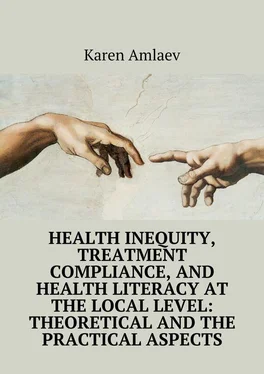The differences in education related, to a certain degree, to income differentiation, may also reveal themselves in the value and behavioral aspect of the way someone treats his/her own health. In particular, education is connected to the specificity of ordinary health conceptualization, the level of personal responsibility for one’s health status, and the differences in people’s awareness of health issues, healthy lifestyle, and medical care. People with a degree in higher education are usually involved in a wider network of interpersonal connections thus standing a better opportunity to get instrumental and emotional support. The level of education has also been repeatedly noticed to have relation to the differences in the prevalence of health destroying behavior patterns (Демьянова А. А., 2005; Cockerham, 2000; Pomerleau, Gilmore, McKee, Rose, and Haerpfer, 2004). For instance, in 1998 in the female part of the city 64 % of the respondents with a level of education below average referred to their health as poor or very poor, while among those with a higher degree of education the same response was obtained from 20 % only. As for men, about 58 % of St. Petersburg residents with no complete secondary education considered their health as unsatisfactory, while in the most educated segment the same response was given only in 10 % of cases. In the same year the share of respondents with poor health in the first (lowest) and the fourth (highest) income quartiles were: for women – 30 % and 13 %, and for men – 21 % and 4 % (Русинова Н. Л., Браун Дж., 1997, 1999; Rusinova and Brown, 2003).
The economic status is a projection of income inequity, which has direct relation to health inequity. However, the differences in income are also known to reflect the differences in the level of education, the professional background. The educational status in many countries is used as the major indicator of people’s status in the socio-economic inequity hierarchy, while the economic status, in turn, is viewed as the indicator of the return from the investment into the cultural capital. Apart from that education can be considered as an indicator of an increased capacity to take and process information, as well as make decisions allowing taking proper and meaningful approaches to maintaining and caring for one’s own health. There is an obvious relation between income and profession. Low income is typically connected with unqualified heavy physical labor, which, in addition, contains the risk of being injured or maimed.
A separate issue that requires solution within health inequity is marginalized groups that are to be found in any country and in any society. Unfavorable working conditions that potentially exacerbate the impact of environmental risk factors are mostly typical of marginalized groups, such as refugees and migrants even though they could pose a problem for people with a low level of education. The concept of “unfavorable working conditions” may embrace such types as working with no contract signed, child labor, as well as forced and coerced (as a pay for a debt) labor. Working with no contract signed is the major source of inequity in relation to the environment and health, as well as violation of regulations for national labor safety, working hygiene, and working conditions, which involves various negative effects on the health of the employees.
In Hungary, for instance, 15 % of Gypsy settlements (Roma) were located within 1 kilometer from illegal dumps, and 11 % – within 1 km from the places for destroying dead animals (Gyorgy et al., 2005). In Serbia similar settlements had a 2–3 times lower water supply and hygienic facilities (Sepkowitz, 2006).
Therefore health inequity has along historical context; this issue is determined by many factors and is found anywhere regardless of the socio-economic level of development of the country as a whole. Yet, in view of ethical, legal, economic, and medical-social implications this issue requires urgent response at all levels, from local to global.
Health inequity in Russian Federation: state of things
The issue of inequity in income distribution in the post-socialist area has been a subject for wide discussion both in our country and abroad. This point has always been the focus of researchers and politicians, from time to time giving raise to acute socio-political debate. Russia is no exception here given the significant changes it has undergone in the latest decade. Quite a tough issue is developing human potential under rapidly progressing market conditions and similarly rapidly disappearing social benefits for the disadvantaged. In view if this, experts define two types of challenges: on the one hand the country is facing typical of poor countries troubles like spread of communicable diseases, regions with stagnating poverty (still present in Russia), undeveloped infrastructure and high death rate. On the other hand the country is suffering from healthcare and education crisis, and such issues are common for advanced post-industrial countries as well.
Poverty profile in Russia
Poverty in Russia has a number of typical features. For instance, most vulnerable are families with children and, therefore, children themselves, who are under 16. Note to be made though that this issue is not common for most countries. As for retirees they are under lower risks of being affected by poverty because most of them work and the social benefit system is oriented, first of all, at the elderly.
Special mention should be made of the fact that working population is the larger part of the poor group even despite of salary growth. In order to reduce the number of poor people among the working population the minimum salary should be at least 150 % of the minimum cost of living. In the April of 2009 25 % or the working population received their salaries below this minimum. 70 % of them had children. 37,4 % of the working population received salaries below 200 % of the minimum cost of living.
This level of pay for labor is sufficient for meeting the minimum needs of one employee and one child. Therefore, even in a situation where two parents are employed such salaries cannot be enough to support two children at the minimum level.
The largest share of the poor population is accounted for by the people who are able to work, especially youth. Countrymen are more vulnerable to poverty than urban population. Besides, the maximum poverty risk affects the unemployed population, economically inactive groups, as well as those living on social and disability benefits.
Level of poverty and inequity
The dynamics of poverty and inequity is determined by the consumption share for the 20 % of poorest against the total volume of consumption. Up until 2000 this index was about 5,8–6,1 %. Later on the share of the poorest 20 % has gone down, which serves perfect evidence of the fact that the poor have got no access to the results of economic growth.
(The World Bank in Russia Russian Economic Report, No. 21, March 2010, http://siteresources.worldbank.org/INTRUSSIANFEDERATION/Resources/305499-1245838520910/6238985-1269435660465/RER21rus.pdf).
The liberal economic reforms went along with a significant fall in the standard of living and an increase in the socio-economic differentiation. The growing economic inequity has become a serious challenge both for the people and for the government. Our country now has significant inequity in terms of health and accessible medical assistance due to polarization of income and opportunities, which means limited and clearly deficient current social policy carried out in our society. The recent research findings have provided quite a clear demonstration of significant differences in people’s opportunities at birth, during the preschool and school period, in terms of getting access to higher education, housing, transportation, shopping, recreation and fun activities, relationships with the state, access to medical services, life expectancy, maintaining health status and healthy lifestyles, religious affiliation, funeral services, inheritance, etc. Just 20–25 years ago when the disproportion was not so extreme some specialists in social hygiene and healthcare arrangement even talked about potential homogenous conditionality of health in our country.
Читать дальше












